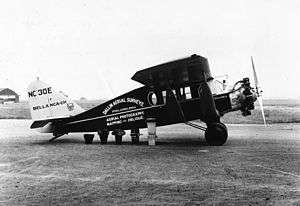Bellanca CH-200
| CH-200 Pacemaker | |
|---|---|
 | |
| Role | Civil utility aircraft |
| Manufacturer | Bellanca |
| Designer | Giuseppe Mario Bellanca |
| First flight | 1928 |
| Developed from | Wright-Bellanca WB-2 |
The Bellanca CH-200 Pacemaker was a six-seat, high-wing, single-engine utility aircraft built in the United States in the 1920s. It was a development of the Wright WB-2 that Bellanca had acquired the rights to in 1926 and was the first Bellanca-branded aircraft to gain a type certificate. The CH-200 was used in a number of pioneering long-distance flights and attempts on distance and endurance records.
Operational history
At the 1928 Los Angeles Air Races, a CH-200 piloted by Victor Dallin took second place in the speed trials (average of 104.65 mph/168 km/h) and won the efficiency trials. The same year, Lt Royal Thomas set a world endurance record of 35 hours 25 minutes in a CH-200 re-engined with a Packard DR-980 diesel engine.
Between 11 December 1928 and 25 June 1929, Peruvian aviators Carlos Martínez de Pinillos and Carlos Zegarra Lanfranco flew a CH-200 named Perú on a tour of Latin America. During that time, they covered 20,635 km (12,866 miles), in 157 hours 55 minutes of total flight, visiting 13 countries and 25 cities along the way.
Specifications
General characteristics
- Crew: one pilot
- Capacity: five passengers
- Length: 27 ft 9 in (8.5 m m)
- Wingspan: 46 ft 4 in (14.1 m)
- Powerplant: 1 × Wright J-5 radial, 220 hp (164 kW)
Performance
- Maximum speed: 126 mph (203 km/h)
- Range: 800 miles (1,290 km)
See also
Related development
References
| Wikimedia Commons has media related to Bellanca. |
- Taylor, Michael J. H. (1989). Jane's Encyclopedia of Aviation. London: Studio Editions. p. 149.
- aerofiles.com
- shanaberger.com